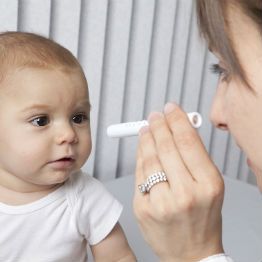Noting that the cases of premature births, which usually develop due to environmental factors, increased by 8 percent in 2015, experts warn families against the risks that premature births carry. Prof. Dr. Hamdi Er from Dunyagöz Altunizade Hospital argues that retinopathy of prematurity, which is common in premature and low birth weight babies, in particular, poses a threat to eye health: “Retinopathy of prematurity, caused by the lack of development of the ocular vessels in premature infants, is a disease that can cause permanent vision loss and blindness in infants. In this rapidly progressive disease, early diagnosis is critical to successful treatment”.
Concentrated oxygen in the incubator affects the vessels of the eyes!
Claiming that the vessels of the eye develop before birth, Prof. Dr. Hamdi Er added: “Because this development cannot be completed in premature infants, it continues after birth. However, the high concentrations of oxygen given to keep premature infants alive cause abnormal development of these blood vessels in the eye.” Prof. Dr. Hamdi Er pointed out that these neovascularizations in the eyes of infants pave the way for retinopathy of prematurity: "These neovascularizations, causing serious visual problems, can cause blindness in the child, especially due to deterioration of the retina and intraocular hemorrhages". Professor Dr. Hamdi Er added that the risk of retinopathy of prematurity is much higher in particular in children born weighing less than 1500 grams: “The reason for this is the need for more intensive oxygen supply and a longer stay in the incubator in children weighing less than 1500 grams”.
Collaboration between pediatricians and ophthalmologists is important
Emphasizing that all infants born before 32 weeks should be screened for ROP, Prof. Dr. Hamdi Er said: “Lung problems, cardiovascular disease, severe infections, and brain problems in premature infants also increase the risk of ROP. For this reason, it is essential that early diagnosis and treatment of ROP in premature infants be carried out by specialized pediatricians and ophthalmologists, and that the family be properly informed”.
The stage of the disease determines the success of the treatment!
Claiming that there are 5 different stages of the disease from mild to severe, Prof. Dr. Hamdi Er emphasizes that the most important factor influencing the success of treatment is the diagnosis and the stage of the disease at which treatment begins. Prof. Dr. Hamdi Er also said that observation is sufficient in the first two stages of the disease: “Necessary injections and laser treatment should be started from the third stage. Because this disease gives the best result when treated in the third stage. However, this success rate, unfortunately, declines in the fourth and fifth stages.” Prof. Dr. Hamdi Er pointed out the importance of examining the eyes of all newborns at the 6th month, not only for ROP but also for the diagnosis and treatment of many eye diseases such as strabismus, eye pressure, and lazy eye syndrome.







